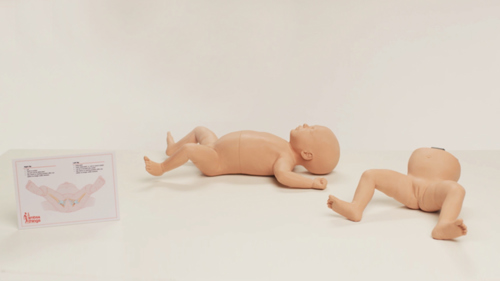The Importance of Correct Training for the Infant Hip Exam
“Only 50% (of Pediatricians) practiced in an institution that endorses a care pathway for DDH”

Developmental Dysplasia of the Hip (DDH) is a highly correctable condition when treated early in life. In fact, there is a global understanding that every infant needs to be examined. However, there seems to be wide variability in the physical exam of an infant hip and even less certainty that validates providers are performing the exam in a way that correctly identifies infants that require treatment.
Early screening for DDH depends on a correct and accurate physical examination of the hip. Universal ultrasound screening of infant hips is not practicable until about 6 weeks of age and depends on the skill of the ultrasonographer. Plain x-rays are not useful until more bone is ossified and routine screening would subject many infants to ionizing radiation. A systematic review of DDH studies published between 1994-2019 states “an ideal screening method should be easy to use, readily available, cost-effective and acceptable to the patient.”1 The study ultimately found that the “combination of the Ortolani and Barlow maneuver …..is the most commonly used method.”1
In practice, 10.3% of surveyed pediatricians reported being only ‘somewhat’ or ‘moderately’ familiar with the Barlow and Ortolani maneuvers”, and that “only 50%...practiced in an institution that endorses a care pathway for DDH”.3 The survey concluded that “there is an opportunity to better distribute and implement DDH guidelines. The large number of pediatrician respondents who would not refer patients to a specialist or order imaging studies appropriately represents an opportunity for education.”3
Without proper training in the performance of the Barlow and Ortolani maneuvers, providers may fail to pick up an irreducible dislocation, subluxable hip, and dysplasia without dislocation.1 Left undetected, these conditions “may progress and present later.1
Dr. Joseph Lopreiato MD, MPH2, a practicing pediatrician and simulation expert found similar results while teaching pediatric residents. He “observed learners performing infant hip exams in the clinic” and noticed that “their techniques were all over the place.” He states that when asked “how they learned their exam technique, most would say ‘in medical school’, but could not recall if they ever got feedback on their performance.” Dr. Lopreiato and his team altered a toy doll to help demonstrate the proper exam because there was nothing in the simulation market that was able to fully abduct or adduct the hips.

Limbs & Things, together with Dr. Lopreiato, has created the Infant Hip Examination Trainer, a model designed to meet the specific requirements of healthcare professionals to identify and diagnose DDH. This infant hip trainer comes with 2 interchangeable lower leg modules that allow trainees to identify the differences between normal and abnormal hip pathologies. The models demonstrate some subtle, but important signs such as symmetric and asymmetric skin folds and the hip joints are designed to allow:
- Dislocating a hip that is lax in the socket (a positive Barlow sign)
- Relocating a hip that is dislocated from the socket, feeling the “clunk” as the procedure is completed (a positive Ortolani sign)
- Using the Galeazzi sign to identify asymmetry in thigh lengths
- Comparing and contrasting a normal infant hip with one that is suspicious for DDH
There is clearly an opportunity to improve training in the care of DDH for our children. If you are interested in knowing more about the Infant Hip Examination Trainer, do not hesitate to reach out to one of our team members or our customer service department for more information.
References:
1 SCREENING OF NEWBORNS AND INFANTS FOR DEVELOPMENTAL DYSPLASIA OF THE HIP: A SYSTEMATIC REVIEW
2 JOSEPH O. LOPREIATO, MD, MPH, ASSOCIATE DEAN FOR SIMULATION EDUCATION, VAL G. HEMMING SIMULATION CENTER
3 DEVELOPMENTAL DYSPLASIA OF THE HIP: AN EXAMINATION OF CARE PRACTICES OF PEDIATRICIANS
Did you like this article?
The Importance of Correct Training for the Infant Hip Exam

